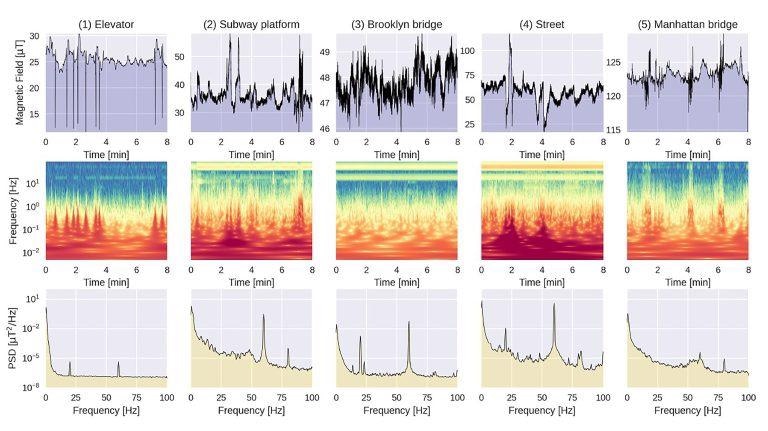Assessing the magnetic footprint of a city could be used to track its health, including a potential early warning system for pollution problems and as a tool for improving energy efficiency.

Five samples of magnetic field time series at five different locations in Brooklyn. From left to right: (1) Elevator measurements were taken on the 12th floor of Transit Building; (2) Subway measurements were acquired from the Jay Street Metro Tech station; (3) Brooklyn Bridge measurements were taken underneath the bridge; (4) Street measurements were obtained on the sidewalk in front of the Transit Building in downtown Brooklyn; and (5) the Manhattan Bridge measurements were taken on top of the bridge from the middle of the walkway. Image Credit: Vincent Dumont, Trevor Bowen, Roger Roglans, Gregory Dobler, Mohit S. Sharma, Andreas Karpf, Stuart D. Bale, Arne Wickenbrock, Elena Zhivun, Thomas Whitmore Kornack, Jonathan S. Wurtele, and Dmitry Budker.
Scientists from the United States and Germany have presented a comparative assessment of urban magnetic fields between two US cities: Berkeley, California, and the Brooklyn borough of New York City. They analyzed the kind of information that can be retrieved from magnetic field sensor data to truly comprehend how cities work and also provided perspectives that could be useful for preventative studies.
The research was published in the Journal of Applied Physics from AIP Publishing.
Cities are largely known for their excessive noise levels, making them ideal environments for studying urban science. Magnetic field activity from different sources throughout the city can reveal what is going on over the course of 24 hours.
A city is viewed as a physical system akin to a distant astronomical object that can be studied using a variety of multispectral techniques. In short, our project was inspired by our desire to apply what we learned practicing fundamental physics research to the study of cities.
Vincent Dumont, Lawrence Berkeley National Laboratory
Scientists used synchronized measurements with a network of sensitive magnetometers to gather magnetic field data continuously over a four-week period. Modern data analysis techniques were used to process and analyze the information.
In their current research in which they compared two completely different cities, Brooklyn and Berkeley, they found that Berkeley’s magnetic field activity drops to near zero during the night, whereas Brooklyn’s magnetic field activity remains constant throughout the day and night.
Again, not too surprisingly, we discovered that ‘New York never sleeps,’ or more seriously, there are indeed a number of magnetic signatures specific to each city.
Vincent Dumont, Lawrence Berkeley National Laboratory
The scientists hope that their combination of network magnetometry and smart data analysis will prove to be a useful tool in multidisciplinary urban science.
This work builds on our earlier experiments conducted around the city of Berkeley, in the San Francisco Bay Area. We identified the dominant sources of magnetic signals – which, not too surprisingly, turned out to be the trains of the Bay Area Rapid Transit (BART) system, and learned to glean weaker signals from this dominant background.
Vincent Dumont, Lawrence Berkeley National Laboratory
“We hope this line of research will be picked up and further developed both by the members of our team as well as others, hopefully within cities around the world,” Dumont concludes.
This approach to studying cities through their noise using data from magnetic field sensors has emerged in recent years, and it has been followed by the Center for Urban Science and Progress in New York.
For fundamental physics research, like the Laser Interferometer Gravitational Wave Observatory experiment for gravitational wave detection or the Global Network of Optical Magnetometers for Exotic Physical Searches collaboration for dark matter searches, techniques based on data from magnetic field sensors are especially useful.
Journal Reference:
Dumont, V., et al. (2022) Do cities have a unique magnetic pulse? Journal of Applied Physics. doi.org/10.1063/5.0088264.